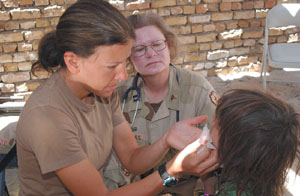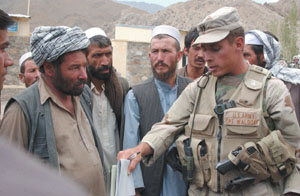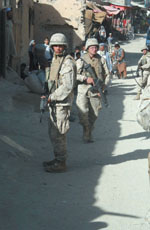Reserve's Mission Challenged by War
 |
 |
| Changing operational requirements in the U.S. National Guard and the Reserve are creating a demand for a variety of skilled individuals such as medical personnel (t) and civil affairs personnel to help rebuild communities in Iraq and Afghanistan (b). |
A rapidly evolving operational environment and new mission priorities are blurring the distinction between the U.S. National Guard, Reserve and active duty forces. As these units continue to operate together, efforts by the U.S. Congress and the U.S. Defense Department will further integrate the different branches of the military through a common payroll system and an occupational skills database.
The ongoing war on global terrorism has stretched the U.S. military across the globe, and it is the Reserve and National Guard that provide the majority of the support and logistics capabilities. But increased manpower needs and restructuring within the services are moving reservists into a more active and central role in combat and civil operations. Instead of being viewed as support or supplementary forces, Reserve units are now a vital part of combatant commanders’ combat power.
During the last three decades of the 20th century, the National Guard and the Reserve were structured as a strategic force to support active duty units in the event of a war with the Soviet Union. Reservists traditionally drilled one weekend a month and had 14 days of annual training that would be supplemented with additional training during a war or general mobilization. But the September 11, 2001, terrorist attacks changed this equation by increasing the operational tempo for instruction and deployment, says Thomas F. Hall, assistant secretary of defense for reserve affairs, Washington D.C.
Hall describes the past four years as a transitional period in which the U.S. military has evolved to meet the threats posed by international terrorist organizations. The change also exposed some inadequacies in the structure of the National Guard and the Reserve’s traditional missions. The demand for skilled personnel for military police, civil affairs units, truck drivers and medical staff suddenly surged, but there were not enough qualified people to fill these billets.
“We don’t know whether we’re out of people, but we’re out of balance,” Hall explains. The imbalance is attributed to the vestiges of the Cold War force structure and its missions. For example, the U.S. Army Reserve is heavy with artillery units. “We were going to use the artillery to fight in the central plains of Europe. Well, we don’t need all that artillery; we need more military police,” he maintains.
Reserve forces are now being restructured to address this imbalance. Some 2.6 million men and women currently serve in the U.S. military, Hall says. Of those, 1.2 million are in the National Guard and in the Reserve. He notes that approximately 100,000 billets are being converted to military occupational specialties (MOSs) that are in high demand. Some of the support activities reservists and National Guard units traditionally performed may be assigned to civilians to free up these forces for other assignments, he says.
These changes are taking place as the Army undergoes its own restructuring. The service is moving away from a division-based structure to one built around modular units that can be deployed rapidly and combined to meet specific mission requirements. The Army is increasing the number of its battalion combat teams (BCTs) from 33 to 43, and the National Guard also is raising its BCTs to 34—for a combined total of 77 BCTs across the entire Army, Hall says.
Other issues that surfaced during this transition period are discrepancies in pay, training and mission utilization between Reserve and active duty forces. Many of these differences are tied to a Cold War strategic paradigm that is not compatible with current requirements. Hall notes that roughly 50 different provisions in last year’s Defense Authorization Act are designed to redress some of these variances and to aid the National Guard and the Reserve in general.
Another major issue facing the Reserve is the adequate use of skilled personnel. Until recently, no means were available to track an individual soldier’s expertise beyond the MOS. “We have not had the rules, policies and perhaps as much thought needed to tap the tremendous capacity brought by guardsmen and reservists, particularly in high-technology skills,” Hall admits.
The military’s service requirements are rigid, with reservists either on active duty or assigned to drilling in the Reserve. Hall proposes changing this pattern with what he refers to as a “continuum of service” that would flexibly tap into this pool of expertise. For example, Arabic language speakers are currently in high demand across the military. “We need them for perhaps two years of service. But when they come off service, we don’t need to keep them in a drilling status where they practice their Arabic every week,” he says.
Instead, skilled reservists such as linguists and information technology specialists would revert to inactive status, possibly without the need for regular drills, until they are called back for duty. Hall notes that many individuals leave active duty to enter the civilian work force or to raise families and often return to the Reserve or National Guard. But this is discouraged under the current system where promotions are based on length of service. “I think we need to have a different kind of system that allows a free flow [of personnel status], where we can better capitalize on these technical skills. We are competing with the market place—the people who are wanted by industry are the same ones we want. We have to offer that opportunity, so it’s going to be an entirely new way of thinking about a continuum of service throughout a career,” he says.
Congress currently is considering whether to enact this change in the operational force structure. Through his work with Congress, Hall observes that a number of structural changes have been launched that will affect all branches of the military. In April, the Defense Department began implementing a common pay and personnel system that creates single data entry points for record keeping (SIGNAL, January 2004, page 17). When people shift from active duty to the National Guard or to the Reserve, their information will seamlessly follow them. This system replaces stovepiped systems used by active duty and reserve forces that were often unable to share information.
 |
| As reserve and active duty forces continue to work together in operations around the world, the distinction between these types of units will continue to blur. Hall maintains that commanders view soldiers such as these National Guardsmen in Afghanistan as an integrated part of their combat strength. |
The database also will allow Pentagon planners to know the types and numbers of reservists being deployed. For example, the system can provide information about how many first responders are mobilized as well as about their home states. Hall explains that this data can then be shared with states for homeland defense purposes to ensure that adequate levels of personnel remain in the event of a domestic emergency.
Tracking expertise is vital in a volunteer military with limited manpower resources, Hall says. This capability is especially important as demand for certain MOS billets increases. For example, civil affairs personnel are needed for reconstruction work in Iraq and Afghanistan. He notes that this particular billet requires a variety of skills, including knowing how to organize a city council or manage municipalities or public works systems such as water and electricity.
Other valuable skill billets include information technology specialists, linguists, military police and medical personnel. Arabic and Farsi translators are especially important. Hall believes that the Defense Department should examine how these Middle Eastern languages are taught in military and civilian schools to cultivate translators better throughout the armed forces. “In reality, all of the skills that are needed in the civilian world are required to a degree in the military,” he says.
Reserve and National Guard units also have learned many hard lessons from recent combat operations. One important experience gleaned by all the services is that front lines do not exist against a shadowy enemy capable of striking U.S. territory. The military learned to be more flexible in countering the threats posed by rapidly changing enemy tactics in Iraq. Hall explains that, through the efforts at facilities such as the National Training Center, Fort Irwin, California, intelligence on insurgent or terrorist strategies can be converted quickly into updates that can be sent to units within 24 hours.
The distinctions between active and reserve forces are fading. Hall explains that when combatant commanders look at soldiers, sailors, Marines or airmen, they do not distinguish between active duty and reserve personnel because they all conform to the same training, operational and equipment standards. “I see that as a real difference and a giant step toward integrating our armed forces,” he says.
However, the Reserve continues to face personnel retention issues. Hall notes that after most conflicts, such as the first Gulf War, recruiting and retention usually drop. Most of the Reserve’s components will be able to meet their manpower requirements, but the Army National Guard and Army Reserve continue to have the most difficulty in this area, he says. To counter this trend, some 2,400 new recruiters will be put into the field for both the Guard and the Reserve. Reserve recruiters will be armed with a new bonus authority provided by Congress to offer enlistment bonuses ranging from $10,000 for first time recruits to $15,000 for veterans signing up for six years.
While attracting new recruits continues to be a challenge, reserve and active duty forces are enjoying steady retention rates. But active duty retention means that fewer of the Reserve’s traditional recruits—veterans—are available. Because fewer personnel are leaving the armed forces, the Reserve has increased its efforts to attract recruits with no previous military experience. Unfortunately, the active duty forces and the business sector also are drawing from the same manpower pool, Hall says.
The other challenge is getting the right personnel management and payroll systems in place while government willpower and resources are available. Hall sees this as a unique opportunity. “I think that we’re being handed, on a silver platter, a once-in-a-lifetime opportunity to fully integrate the Guard, the Reserve and active duty force. We’ve talked about it for years, but if we don’t achieve it now, we’re never going to,” he says.




Comments